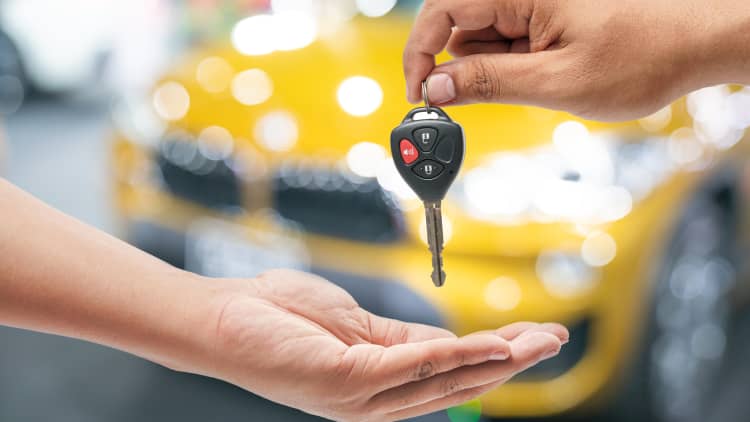Hero Images | Getty Images
It’s getting harder to find new, cheap cars, according to auto experts.
Consider this: In July, just one car model — the Mitsubishi Mirage — had an average new-vehicle transaction price below $20,000, according to Kelley Blue Book data. By comparison, there were a dozen vehicles that met that pricing criteria five years ago.
The $20,000-or-below barometer is a sort of unofficial price threshold for an affordable new car, said Brian Moody, executive editor for Kelley Blue Book.
“There aren’t as many inexpensive new cars as there used to be,” Moody said.
Transaction price doesn’t tell the full story, of course, experts said. That price records what the average buyer pays — a variable that depends on factors such as markups and promotions by car dealers and any add-ons selected by buyers at the time of purchase.
Manufacturers such as Kia, Hyundai and Nissan — in addition to Mitsubishi — currently sell cars whose base models carry a sticker price below $20,000, Moody said.
But this list has gotten smaller over the past five or so years, said Tom McParland, owner of Automatch Consulting, a car-buying service for consumers.
“Whether you’re buying new or used, that kind of affordable segment — sub-$20,000 — is challenging,” he said.
‘Americans don’t like not having features’
Consumers were able to find entry-level vehicles with a $15,000 starting price as recently as a few years ago, said Paul Waatti, an industry analyst at market research firm AutoPacific.
The dearth of options today is due to a multitude of factors, experts said.
Among them is consumer preferences — people tend to want models with more features, Waatti said.
“Culturally, Americans don’t like not having features in their car,” such as automatic climate control, a car play screen and parking sensors, said Joseph Yoon, a consumer insights analyst at car website Edmunds.
Auto manufacturers know this to be true and use it to their advantage in marketing, Waatti said.
“Automakers obviously want to be able to tell that they’re offering an affordable vehicle and they can do that in messaging,” he added. “But when it comes down to it, they’re not building many of those lower-price models.”
Instead, automakers will make more of the higher-end models with features that consumers want, added Yoon.
In fact, car sales in the luxury market segment have increased, Moody said. They now account for about 20% of total new car sales, up from roughly 10% to 13% before the Covid-19 pandemic, he said.
Five years ago, there were 12 vehicles selling for an average price of more than $100,000. Today, there are 32 vehicles, according to Kelley Blue Book data. Both tallies exclude “super exotics” from companies such as Ferrari, Lamborghini and Rolls-Royce.
Inflation for new and used cars also surged during the pandemic era, leading to higher vehicle prices. Materials and supplies became more expensive, driving up production costs for auto companies, said Waatti, and those higher costs are at least partly passed on to buyers.
Higher interest rates may also be keeping would-be buyers out of the car market right now, experts said.
Since buyers who generally shop for the least expensive cars tend to be budget-constrained, their absence from the market may be skewing average purchase prices higher, they said.
The average new-vehicle purchase price today is about $48,000, up from about $30,000 in 2012, according to Kelley Blue Book.
Four tips for consumers to find cars at a good price
Here are some general tips for consumers to find a reasonably priced car.
1. Know your budget — really
Most car buyers use monthly payments to conceptualize how expensive a car is.
However, consumers should know their overall budget before shopping by using an online auto loan calculator, McParland said. Otherwise, it’s hard to know if you’re getting a good deal, he added.
Certain auto loan calculators let consumers work backwards, by plugging in a monthly payment that fits their budget, along with other estimated information such as the loan’s term and interest rate. The output: the total vehicle price a buyer can afford.
“This is probably the best step any customer can take,” McParland said.
2. Look outside your local market
Casting a wide net during a car search yields more potential inventory and leverage against dealerships, McParland said. Some markets are “better than others,” and looking even an hour or two away will “very likely get you a more competitive deal,” he added.
3. Get prices in writing beforehand
Confirm car prices in writing with a dealer before walking in the door, McParland said. A refusal to do so is a red flag, he said.
“It’s code for, ‘We’re going to try to rip you off,'” he said.
4. Shop your financing
Don’t depend on a dealer’s financing offer.
Dealers can profit off consumers by offering a higher-than-necessary interest rate, experts said. That’s why it’s a good idea to get pre-approval for an auto loan — perhaps from a local bank, credit union or online lender — before setting foot in the dealership, they said.
These offers can provide leverage for a better rate at the dealership and are especially useful for buyers with credit scores below 700, who are unlikely to qualify for the best available rates, McParland said.
Credit: Source link




